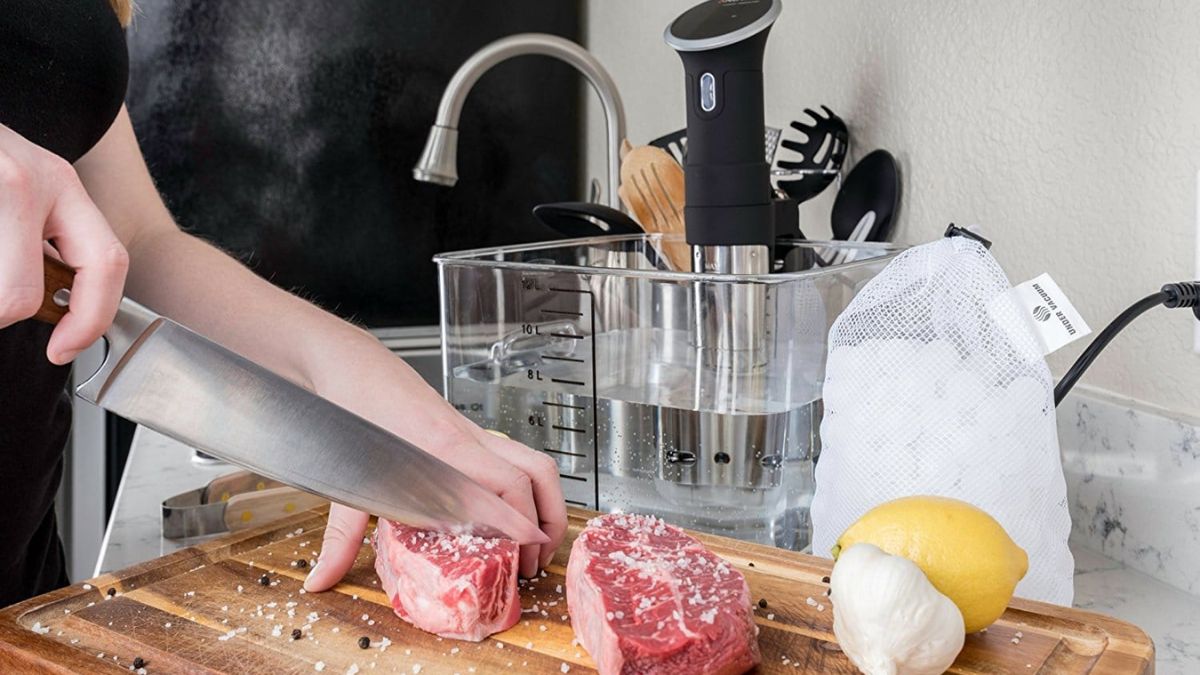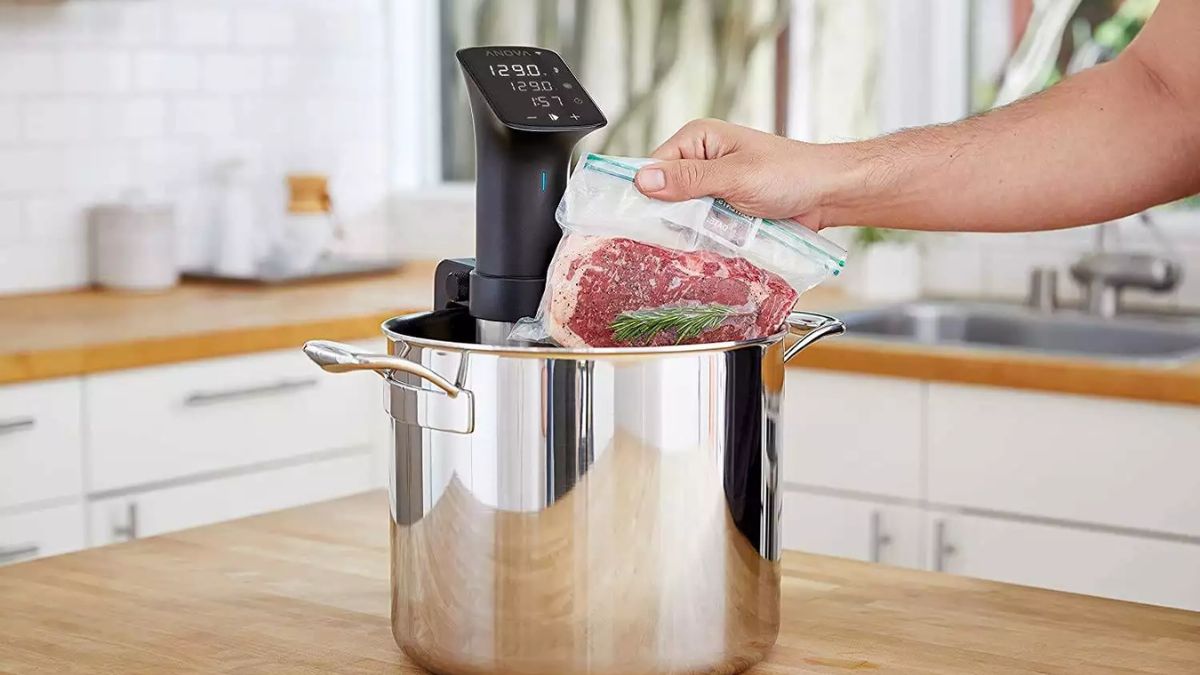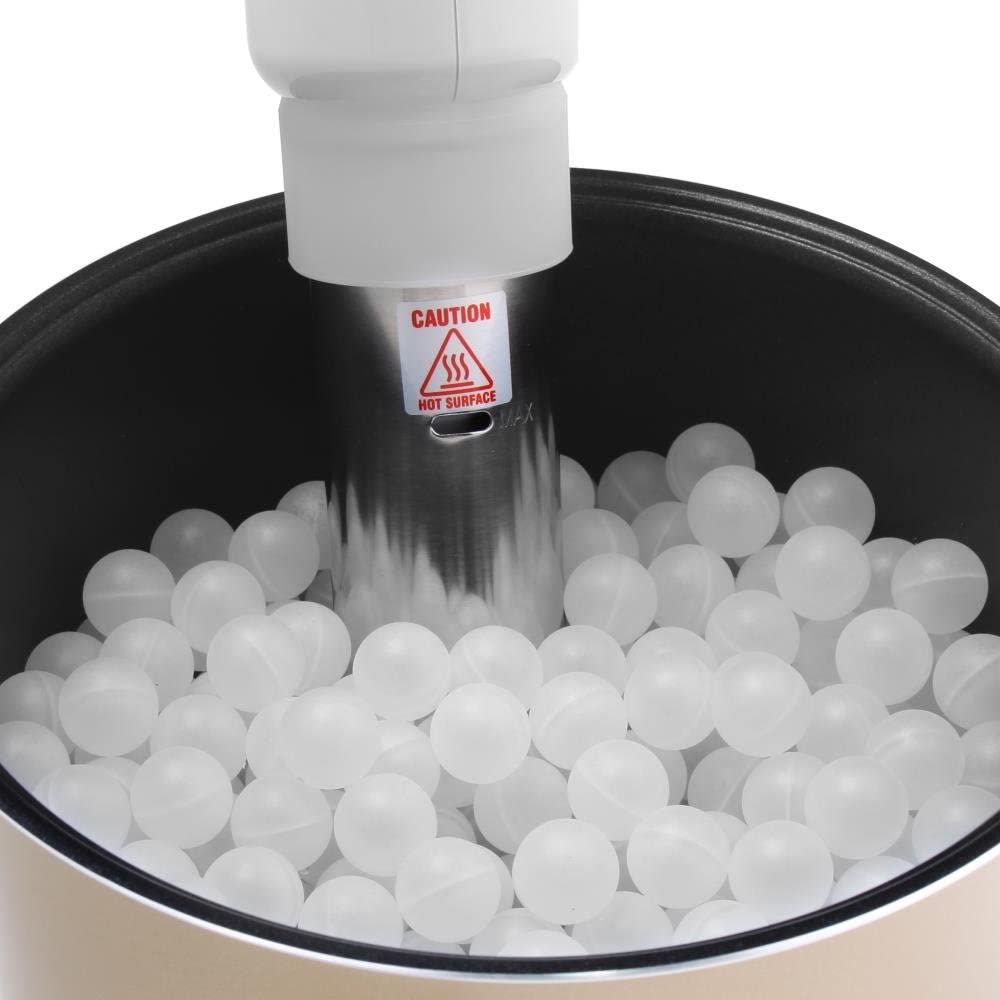People often use the water from their sous vide bags to wash or soak their dishes at the end of the meal if the water is clean and the bags don’t leak. People also often let the water cool down and then water their plants. If you don’t plan to use the sous vide cooker often or for a long time, you don’t need the cover. But it is very important for dishes that take a long time to cook. With a lid, water won’t evaporate, and heat won’t escape.
What are Sous Vide Balls for?
Sous vide balls cover vessels or pots during cooking to keep them from losing heat or moisture. This is especially helpful when cooking food for a long time. As the balls rise and fall, the heat builds up at the bottom and stays in the container. Food can cook evenly and thoroughly because the steam is spread out over the whole surface of the container.
This makes the steaks, pork chops, and baby back ribs juiciest and gives them more natural flavor, heartiness, and nutrition. Why does your sous vide container need a lid? Even though your Anova can keep the temperature steady for days without a lid or insulation, insulation can help when cooking sous vide by stopping water from evaporating. Insulation helps keep water from leaving the pot.
Sous Vide Balls vs. Regular Ping Pong Balls
- A regular ping-pong ball is made for table tennis, so it needs to be more durable.
- The ping pong ball is made of celluloid, a stiffer type of plastic, and layers of camphor and nitrocellulose, which are transparent and flammable types of plastic.
- Sous Vide Ping Pong Balls are made of polycarbonate, plastic, foam, or other shapeless, malleable materials and are round and flexible.
- The cooking pot and the lid where the sous vide balls go are made of the same materials.
- The balls are the right size and shape to fit inside a cooking pot or other container.
- That means you can use containers of different sizes without buying lids for each one. You only need sous vide balls.
- You can make a small meal in a pot one night and a big meal in a bigger plastic container the next. You are no longer stuck with just one container.
- Sous vide balls are made to cook and keep steam from escaping from a sous vide container. Ping-pong balls are made to bounce.
How to Use Sous Vide Ping Pong Balls?
It’s easy to use sous vide balls. The balls need to be put in the water, and they will float on the water’s surface to keep the hot water from evaporating. You can put them in before the food to speed up the healing process, or you can put them in after the food. Use the sous vide balls instead of a container lid, foil, or plastic wrap.
Sous vide balls are easy to take care of because they don’t need much cleaning. Dump the water and put the balls in a filter when you’re done cooking. Most sous vide balls, like the ones I use and love, come in a mesh bag and can be put back in the bag to finish drying. You could also put them in your sous vide container to make storage easier! Then, you must get your container with the sous to vide balls and add water.
Why is Sous Vide Balls Needed?
It turns out that leaving a large vat of water out at temperatures between a hot bath and boiling for longer than sous vide usually calls for has an unintended result: evaporation. Sous vide is being used for more and more things, and because of this, recipes like short ribs, chuck roast, and pulled pork, which all need to soak and cook for at least 24 hours, are being made.
When an open hot water bath is left unattended for that long, the water can evaporate into the air until the sous vide machine turns itself off for an unknown time. This makes it hard for the cook to decide whether to end the recipe or guess how long it has been inactive and add hot water based on that.
NutriChef Premium Sous Vide Balls
What are the Benefits of Sous Vide Ping Pong Balls?
The main benefits of sous vide balls are that they are flexible, affordable, convenient and easy to clean.
1. Heat Insulation
The blanket of insulation is the most important benefit. The water that evaporates turns into steam, which condenses on the balls and keeps the water in the container.
2. Flexible Sizes
Sous vide balls can be used in any size or shape of the container, as long as there are enough balls to cover the top of the water bath container.
3. Cheaper
A standard lid costs double what a package of balls does. Most of the time, I would buy 75 to 100 sous vide balls in a package.
4. Easy Access to Food
I like that I don’t have to deal with a lid or plastic wrap when I want to add more food, move it, or take it out. I just put a pair of tongs in the container or pull the bag out.
5. Easy Cleanup
When I’m done cooking, I use a filter to catch the sous vide balls in the water as it drains and let them dry. You can store them in a bag or a pot so they won’t take up much more room.
Where do Sous Vide Balls Come in?
Cooks who know much about physics have started using ping pong balls instead of foil, plastic wrap, or cutting up their container lids. These hollow plastic balls float on top of the hot water, keeping the bath from getting too hot. Also, the Ping-Pong balls help the steam condense back into hot water, which allows the water to drip back into the water bath. Even though the Lid Method and the Foil/Plastic Wrap Method work for what they are meant to do, using Ping Pong balls as a makeshift “cover” has a few extra benefits:
Plastic balls can be used over and over again. To dry them, you must get rid of the water in the sous vide container. That’s all there is to do. Since the water is already hot, it evaporates from the wet Ping Pong balls in just a few minutes. No need to dry, so no waste. A layer of thin plastic balls takes on the shape of the container. This makes it easy to put things in and take them out of containers of any size without wrapping and securing them.
Plastic wrap, holes cut into the lid, and foil is used to direct the steam away from the sous vide unit. As these units are made to handle small amounts of steam, they are not made to handle the steam from a full hot water bath condensed into a small area. The shape of a sphere makes it possible for steam to rise evenly over the whole surface of the container. It’s easy to check on a cook because you can easily lift and drop dozens of balls from the hot water bath while it’s cooking, and you don’t have to take off and put back plastic or foil to lift cooking items from inside the tub.
What are People Doing About it?
Many people have started cooking their sous vide recipes in large plastic containers instead of pots to get around this problem. Plastic is a much better insulator than metal, so it helps the water stay at the same temperature for longer. Plastic also helps save energy because it insulates better than other materials.
Some chefs have added to this plastic container sous vide method by putting aluminum foil or plastic wrap over the top of their plastic containers. This keeps heat from escaping and keeps cooks from having to cut a permanent hole in the lid of a plastic storage container the size of a sous vide cooker. This means that the container can never be used for its original storage purpose again.
Conclusion
With the invention of small, portable sous vide machines for use at home, the idea of cooking food in plastic bags in temperature-controlled hot water baths has quickly become popular. As this way of cooking has become more popular, problems have come up with recipes that need to be in the heated water for a long time. The sous vide ping pong balls are a great option because you can cook more or less depending on what you want.
The only problem is that they aren’t as good as ping-pong balls, and you can still play with them if you want to. The balls also help keep the water from evaporating, so you don’t have to add water as often (or at all) when cooking for longer periods. You also want to keep the heat in the water so that steam doesn’t form near the sous vide device.



